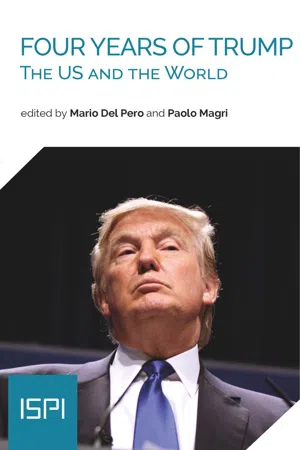![]()
PART I
THE US IN THE MIRROR.
HOW THE US HAS CHANGED
![]()
1. Divide et Impera:
Polarization in Trump’s America
Gary C. Jacobson
The devastating social and economic dislocations spawned by the coronavirus pandemic that struck the United States (and the world) in early 2020 gave Donald Trump the defining challenge of his presidency. Uniting the country against a common threat is basic to the president’s job description, and the moment clearly cried out for unifying national leadership. Trump claimed the mantle of wartime President but could summon neither the will nor capacity to craft and stick to a unifying message. Having built his entire political career on mobilizing grievances, sowing discord, spinning lies, and savaging critics, Trump stayed true to form as the crisis unfolded, using his press briefings and tweets to praise himself and rewrite history while issuing crude attacks on anyone in politics or the media who dared to question his administration’s decidedly questionable performance. In a crisis demanding coordinated, coherent, and informed national action, Trump continued to preside as always: impulsively, erratically, and ignorantly, with contradictory messages that extended to floating quack remedies and cheering on populist protests against his own administration’s policies. In other words, he remained the same Donald Trump on display from the beginning of his campaign for the presidency in 2015 through his first three years in office.
The pugnacious, unscripted style that had enabled his hostile takeover of the Republican Party, got him elected in 2016, and seen him through various sex scandals, the Mueller investigation, and impeachment no longer fit the moment, but Trump would or could not adapt to the radically altered context of his presidency. To the contrary; he doubled down on his stock strategy of mobilizing the illiberal sentiments of his white populist base at the cost of aggravating partisan, racial, and regional conflicts. Rather than unite the country, Trump left it nearly as polarized over his response to the communal disaster as it had been over his earlier impeachment and acquittal. As a result, the gravest and most disruptive crisis to hit the United States since the Second World War did almost nothing to alter existing political battle lines – at least in the short run.
Prior to the pandemic, Trump’s genius for exciting and exploiting discord had given him the most polarized presidential job approval ratings in modern American history. His new record was, however, only the latest extension of a long-term trend. The partisan divide in opinions of presidents had been growing wider for several decades and had reached new highs during the presidencies of his immediate predecessors, George W. Bush and Barack Obama. The trend is summarized in Figure 1.1, which displays the annual averages in the partisan gap in presidential approval ratings in Gallup Polls taken since the Truman administration. The gap expanded in stages, initially with Ronald Reagan and Bill Clinton, then further with G.W. Bush and Obama, and finally to new extremes during Trump’s presidency. Since the beginning of 2019, partisan differences in opinions of Trump’s performance has averaged a remarkable 83 points, with an average 90% of Republicans but only 7% of Democrats approving of his job performance.
Fig. 1.1 – Partisan Differences in Presidential Job Approval, 1945-2020 (Annual Averages from Gallup Polls)
The growing party gap in presidential approval is but one symptom of widening divisions in the electorate that have both echoed and reinforced party polarization in Washington. Trump’s victory in 2016, and the remarkably divisive presidency it launched, are the end products of decades of deepening elite and mass partisan division fused with his singular character, a fateful meeting of opportunity and opportunist. Trump’s presidency is also scarcely conceivable without Obama’s. This chapter begins summarizing the developments in the party system that set the stage for the intense partisan conflicts of the Obama years, and then it considers how the lines of cleavage amplified by the Obama presidency, and the social and economic dislocations they reflected, made Trump’s election possible. The course of the Trump presidency, and the starkly divergent reactions it has provoked, are the subjects of the third section. The final section reviews Trump’s response to the coronavirus pandemic and to a second test of his leadership, the protests sparked by a video of the brutal killing of an unarmed Black man, George Floyd, by a Minneapolis policeman, consider how far Trump’s go-to strategy of deception and division remains viable, and speculate briefly about his legacy, win or lose in 2020.
Polarization Before Trump
Trump’s disruptive presidency was made possible by a long-term reordering of elite and mass party politics in the United States. In the decades leading up to the 2016 election, the nation had by almost every measure grown increasingly polarized along party lines. Deepening conflict was most obvious at the elite level in the frequent public clashes between partisan warriors in Washington, but it emerged in the broader public as well. From the 1970s onward, largely in response to the more sharply differentiated alternatives offered by the national parties and their candidates, Americans gradually sorted themselves into increasingly distinct and discordant Republican and Democratic camps. Their partisan identities, ideological leanings, and policy opinions became more consistent internally and more divergent from those of rival partisans. Political cleavages that once divided up the public in diverse ways grew more coincident, leaving partisans on opposite sides on a growing range of issues. Traditional disagreements over the role and size of government (with a focus on taxes, regulation, and the social safety net) widened, as did disagreements about social issues such as abortion, same-sex marriage, immigration, race and gun control. Partisans moved apart on beliefs about reality as well as in values and opinions; most Democrats, for example, came to believe that humans are heating up the planet, with potentially dire consequences; most Republicans did not. Polarization also had an affective comp...

